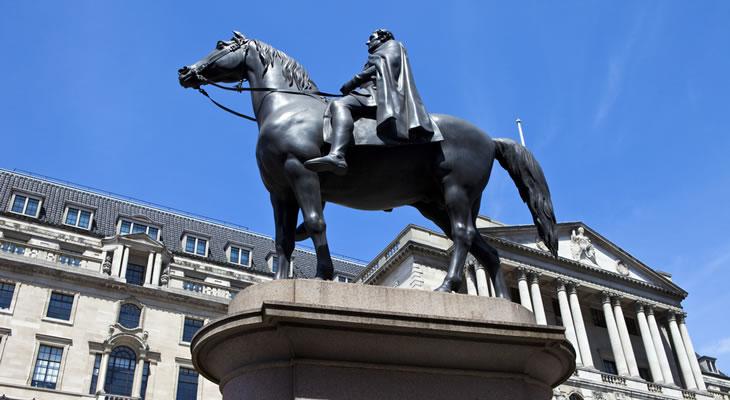The Pound Australian Dollar exchange rate could be set to weaken if complications with UK monetary policy continue. Meanwhile, the Australian Dollar may be currently riding high on strong iron ore prices, but can this trend continue for long?
Bank of England Monetary Stimulus Gets Off to a Bumpy Start, Long-Term GBP Forecasts Weaken
The Pound was on its longest losing streak since the result of the Brexit referendum was announced at the time of writing. Five days of successive declines followed the Bank of England’s (BoE) monetary policy decisions, which saw huge stimulus unleashed. Several downside risks to the Pound emerged since the meeting, including a strong belief that further easing would be required. Before focussing on that, it’s worth taking into account the fact that there were headwinds facing the initial easing announced at the August 4th policy meeting as well.
The BoE faced a severe obstacle in its attempts to increase asset purchases under its quantitative easing programme, after it failed to find enough bonds to meet its first call for securities. The BoE had wanted to purchase £1.17 billion worth of government bonds dated longer than 15 years, but only received enough offers from the bond market to buy £1.118 billion. If this pattern continues, the BoE will have to rethink its stimulus package and potentially switch to other policy tools in an attempt to stimulate the UK economy. This rethink could delay its efforts, potentially keeping the Pound weaker for longer.
Societe Generale Fixed-Income Strategist Jason Simpson explained;
‘You’d understand why investors might not be keen to offload longer bonds — if you are looking for yields that’s the only place on the curve to be. It is a bit of a surprise that this went uncovered in the first week of the operation, goodness knows what happens next week.’
Markets were already expecting more easing, even before the latest setbacks, but the complications with QE could push the chances of further stimulus even higher. BoE policymaker Ian McCafferty, usually one of the most hawkish members of the Monetary Policy Committee (MPC) wrote in The Times that;
‘If the economy proves to have turned down in line with the initial survey signals, I believe that more easing is likely to be required, but that can easily be delivered in coming months.’
In response to the development, the Bank of England said that it would simply include the shortfall in its targets for asset purchases in six months’ time, when the second stage of the programme gets under way. Many analysts have commented that this amounts to simply ‘kicking the can down the road’, however, so it remains to be seen whether the BoE will have any luck finding the required amount of bonds in the future.
Given that GBP AUD exchange rates have been on a bumpy but pronounced decline since the UK referendum – and taking into account the raft of poor data and stimulus expectations – it is possible the Pound may remain the weaker of the two currencies going forward.
Is an Iron Ore Price Slump Coming to Weigh on Australian Dollar Medium-Term Forecasts?

At the time of writing, the Australian Dollar was strengthening on the back of surging iron ore prices. Government efforts in China to curb the steel industry have largely failed, boosting confidence in the demand for iron going forwards. Chinese demand for iron ore grew 8.1% on the year in July, with imports hitting 88.4 million tonnes – the second highest on record. To date, the country has imported 582 million tonnes, with total imports by the end likely to brush a record 1 billion tonnes. Iron has surged to over US$60, taking total gains made this year up to 43%. Prices are still a long way from their peak in 2011 – around a third of the value – but producers are stepping up their efforts in order to capitalise upon the new opportunities for profit.
However, the authorities are still attempting to curb capacity and Chinese domestic iron ore production is increasing as well, lessening the need for overseas imports. According to Reuters;
‘It’s still likely that China’s iron ore market will be oversupplied in 2016 when imports and domestic productions are put together. This may explain why the forward curve of the main iron ore contracts are pointing to considerably weaker prices next year.
The Dalian futures curve is showing that prices will fall by almost 18 percent from September to July next year, while the Singapore curve shows an identical decline, from $62.40 a tonne in September to $49.45 by July.’
This presents potential downside risks to the Australian Dollar, whose strength and weakness has closely tracked developments in iron ore. At the end of December 2015, when iron ore was US$39.60 per tonne, the Australian Dollar Pound (AUD GBP) exchange rate was 0.4942; at the time of writing iron ore was around US$60 per tonne, while the ‘Aussie’ trended at 0.5908, up around 19%. So falling iron prices will have a significant dragging effect on the Australian Dollar. This would play into the hands of the Reserve Bank of Australia (RBA), however, which believes the ‘Aussie’ is overvalued. This would lessen the chances of further interest rate cuts, curbing some AUD GBP exchange rate losses in the long-term.
GBP AUD Exchange Rates, 9th August 2016
At the time of writing the Pound Australian Dollar (GBP AUD) exchange rate was continuing a two-day decline, having dropped from a pre-BoE meeting 1.7498 to 1.6902, while the Australian Dollar Pound (AUD GBP) exchange rate was trending at a two-and-three-quarter year high of 0.5916.


Comments are closed.